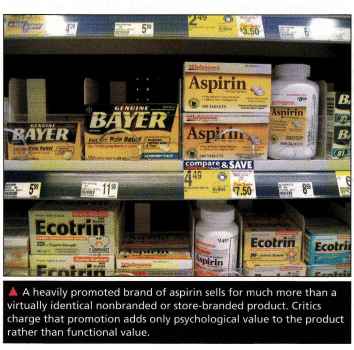Marketings Impact on Individual Consumers
Consumers have many concerns about how well the American marketing system serves their interests. Surveys usually show that consumers hold mixed or even slightly unfavorable attitudes toward marketing practices. Consumer advocates, government agencies, and other critics have accused marketing of harming consumers through high prices, deceptive practices, high-pressure selling, shoddy or unsafe products, planned obsolescence, and poor service to disadvantaged consumers. Such questionable marketing practices are not sustainable in terms of long-term consumer or business welfare.
High Prices
Many critics charge that the American marketing system causes prices to be higher than they would be under more "sensible" systems. They point to three factors—high costs of distribution, high advertising and promotion costs, and excessive markups.
High Costs of Distribution. A long-standing charge is that greedy channel intermediaries mark up prices beyond the value of their services. Critics charge that there are too many intermediaries, that intermediaries are inefficient, or that they provide unnecessary or duplicate services. As a result, distribution costs too much, and consumers pay for these excessive costs in the form of higher prices.
How do resellers answer these charges? They argue that intermediaries do work that would otherwise have to be done by manufacturers or consumers. Markups reflect services that consumers themselves want—more convenience, larger stores and assortments, more service, longer store hours, return privileges, and others. In fact, they argue, retail competition is so intense that margins are actually quite low. For example, after taxes, supermarket chains are typically left with barely 1 percent profit on their sales. If some resellers try to charge too much relative to the value they add, other resellers will step in with lower prices. Low-price stores such as Wal-Mart, Costco, and other discounters pressure their competitors to operate efficiently and keep their prices down.
High Advertising and Promotion Costs. Modern marketing is also accused of pushing up prices to finance heavy advertising and sales promotion. A For example, a few dozen tablets of a heavily promoted brand of pain reliever sell for the same price as 100 tablets of less-promoted brands. Differentiated products—cosmetics, detergents, toiletries—include promotion and packaging costs that can amount to 40 percent or more of the manufacturer's price to the retailer. Critics charge that much of the packaging and promotion adds only psychological value to the product rather than functional value.
Marketers respond that advertising does add to product costs. But it also adds value by informing potential buyers of the availability and merits of a brand. Brand name products may cost more, but branding gives buyers assurances of consistent quality. Moreover, consumers can usually buy functional versions of products at lower prices. However, they want and are willing to pay more for products that also provide psychological benefits—that make them feel wealthy, attractive, or special. Also, heavy advertising and promotion may be necessary for a firm to match competitors' efforts—the business would lose "share of mind" if it did not match competitive

A heavily promoted brand of aspirin sells for much more than a virtually identical nonbranded or store-branded product. Critics charge that promotion adds only psychological value to the product rather than functional value.
fccairm B
spending. At the same time, companies are cost conscious about promotion and try to spend their money wisely.
Excessive Markups. Critics also charge that some companies mark up goods excessively. They point to the drug industry, where a pill costing five cents to make may cost the consumer $2 to buy. They point to the pricing tactics of funeral homes that prey on the confused emotions of bereaved relatives and to the high charges for auto repair and other services.
Marketers respond that most businesses try to deal fairly with consumers because they want to build customer relationships and repeat business. Most consumer abuses are unintentional. When shady marketers do take advantage of consumers, they should be reported to Better Business Bureaus and appropriate government agencies. Marketers also respond that consumers often don't understand the reasons for high markups. For example, pharmaceutical markups must cover the costs of purchasing, promoting, and distributing existing medicines plus the high research and development costs of formulating and testing new medicines. As pharmaceuticals company GlaxoSmithKline states in its ads, "Today's medicines finance tomorrow's miracles."
Deceptive Practices
Marketers are sometimes accused of deceptive practices that lead consumers to believe they will get more value than they actually do. Deceptive practices fall into three groups: pricing, promotion, and packaging. Deceptive pricing includes practices such as falsely advertising "factory" or "wholesale" prices or a large price reduction from a phony high retail list price. Deceptive promotion includes practices such as misrepresenting the product's features or performance or luring the customers to the store for a bargain that is out of stock. Deceptive packaging includes exaggerating package contents through subtle design, using misleading labeling, or describing size in misleading terms.
Deceptive practices have led to legislation and other consumer protection actions. For example, in 1938 the U.S. government reacted to such blatant deceptions as Fleischmann's Yeast's claim to straighten crooked teeth. The government has published several guidelines listing deceptive practices. Despite new regulations, some critics argue that deceptive claims are still the norm. AConsider the glut of "environmental responsibility" claims marketers are now making:
Are you a victim of "greenwashing"? Biodegradable, eco-friendly, recycled, green, carbon neutral, carbon offsets, made from sustainable resources—such phrases are popping up more and more on products worldwide, leading many to question their validity. Last year, for example, the FTC [U.S. Federal Trade Commission] has started reviewing its "Green Guides"—voluntary guidelines that it asks companies to adopt to help them avoid breaking laws against deceptive marketing. "We have seen a surge in environmental claims," says a lawyer at the FTC's Bureau of Consumer Protection. TerraChoice Environmental Marketing, which advises companies on green positioning, reviewed claims companies made about 1,018 widely sold goods. Using measures created by government agencies, TerraChoice concluded that all but one of the claims were false or could be misleading. "There is a lot going on there that just isn't right," says one environmental trend-watcher. "If truly green products have a hard time differentiating themselves from fake ones, then this whole notion of a green market will fall apart," says a Terra Choice executive.6

- Deceptive practices: Despite plenty of regulation, some critics argue that deceptive claims are still the norm. Consider all of those "green marketing" claims.
The toughest problem is defining what is "deceptive." For instance, an advertiser's claim that its powerful laundry detergent "makes your washing machine 10 feet tall," showing a surprised homemaker watching her appliance burst through her laundry room ceiling, isn't intended to be taken literally. Instead, the advertiser might claim, it is "puffery"—innocent exaggeration for effect. One noted marketing thinker, Theodore Levitt, once claimed that advertising puffery and alluring imagery are bound to occur— and that they may even be desirable: "There is hardly a company that would not go down in ruin if it refused to provide fluff, because nobody will buy pure functionality. .. . Worse, it denies . . . people's honest needs and values. Without distortion, embellishment, and elaboration, life would be drab, dull, anguished, and at its existential worst."7
However, others claim that puffery and alluring imagery can harm consumers in subtle ways. Think about the popular and long-running MasterCard Priceless commercials that paint pictures of consumers fulfilling their priceless dreams despite the costs. Similarly, Visa invites consumers to "Enjoy life's opportunities." Both suggest that your credit card can make it happen. But critics charge that such imagery by credit card companies encourages a spend-now-pay-later attitude that causes many consumers to overuse their cards. The critics point to statistics showing that 60 percent of Americans are carrying a continuing balance on their credit cards and that 11.8 million bank credit card accounts are now delinquent. One in every seven Americans today is dealing with a debt collector because they can't make their payments.8
Marketers argue that most companies avoid deceptive practices. Because such practices harm their business in the long run, they simply aren't sustainable. Profitable customer relationships are built upon a foundation of value and trust. If consumers do not get what they expect, they will switch to more reliable products. In addition, consumers usually protect themselves from deception. Most consumers recognize a marketer's selling intent and are careful when they buy, sometimes to the point of not believing completely true product claims.
High-Pressure Selling
Salespeople are sometimes accused of high-pressure selling that persuades people to buy goods they had no thought of buying. It is often said that insurance, real estate, and used cars are sold, not bought. Salespeople are trained to deliver smooth, canned talks to entice purchase. They sell hard because sales contests promise big prizes to those who sell the most.
But in most cases, marketers have little to gain from high-pressure selling. Such tactics may work in one-time selling situations for short-term gain. However, most selling involves building long-term relationships with valued customers. High-pressure or deceptive selling can do serious damage to such relationships. For example, imagine a Unilver account manager trying to pressure a Tesco buyer, or an IBM salesperson trying to browbeat a General Electric information technology manager. It simply wouldn't work.
Shoddy, Harmful, or Unsafe Products
Another criticism concerns poor product quality or function. One complaint is that, too often, products are not made well and services are not performed well. A second complaint is that many products deliver little benefit, or that they might even be harmful.
For example, think again about the fast-food industry. Many critics blame the plentiful supply of fat-laden, high calorie fast-food fare for the rapidly growing obesity epidemic. Studies show that some 66 percent of American adults, for example, and 17 percent of American children are overweight or obese. The number of people in the United States alone who are 100 pounds or more overweight quintupled between 2000 and 2005, from 1 adult in 200 to 1 in 40. This weight increase comes despite repeated medical studies showing that excess weight brings increased risks for heart disease, diabetes, and other maladies, even cancer.9
The critics are quick to fault what they see as greedy food marketers who are cashing in on vulnerable consumers, turning us into a nation of overeaters. Some food marketers

- Harmful products: Is Hardee's being socially irresponsible or simply practicing good marketing by giving customers a big juicy burger that clearly pings their taste buds? Judging by the nutrition calculator at its Web site, the company certainly isn't hiding the nutritional facts.
are looking pretty much guilty as charged. A Take Hardee's, for example:10
At a time when other fast-food chains such as McDonald's, Wendy's, and Subway were getting "leaner," Hardee's introduced the decadent Thickburger, featuring a third of a pound of Angus beef. It followed up with the Monster Thickburger: two-thirds of a pound of Angus beef, four strips of bacon, and three slices of American cheese, all nestled in a buttered sesame-seed bun slathered with mayonnaise! The Monster Thickburger weighs in at a whopping 1,410 calories and 107 grams of fat, far greater than the government's recommended fat intake for an entire day. Surely, you say, Hardee's made a colossal blunder here. Not so! Since introducing the Thickburger, Hardee's has experienced healthy sales increases and even fatter profits.
So, should Hardee's hang its head in shame? Is it being socially irresponsible by aggressively promoting overindulgence to ill-informed or unwary consumers? Or is it simply practicing good marketing, creating more value for its customers by offering a big juicy burger that clearly pings their taste buds and letting them make their own choices? Critics claim the former; industry defenders claim the latter. Hardee's diligently targets young men aged 18 to 34, consumers capable of making their own decisions about health and well-being. And Hardee's certainly isn't hiding the nutritional facts. Here's how it describes Thickburgers on its Web site:
There's only one thing that can slay the hunger of a young guy on the move: the Thickburger line at Hardee's. With nine cravable varieties, including the classic Original Thickburger and the monument to decadence, the Monster Thickburger, quick-service goes premium with 100% Angus beef and all the fixings If you want to indulge in a big, delicious, juicy burger, look no further than Hardee's.
Hardee's even offers a nutrition calculator on its Web site showing the calories, fat, and other content of all its menu items. In this case, as in many matters of social responsibility, what's right and wrong may be a matter of opinion.
A third complaint concerns product safety. Product safety has been a problem for several reasons, including company indifference, increased product complexity, and poor quality control. For years, Consumers Union—the nonprofit testing and information organization that publishes the Consumer Reports magazine and Web site—has reported various hazards in tested products: electrical dangers in appliances, carbon monoxide poisoning from room heaters, injury risks from lawn mowers, and faulty automobile design, among many others. The organization's testing and other activities have helped consumers make better buying decisions and encouraged businesses to eliminate product flaws..
However, most manufacturers want to produce quality goods. The way a company deals with product quality and safety problems can damage or help its reputation. Companies selling poor-quality or unsafe products risk damaging conflicts with consumer groups and regulators. Unsafe products can result in product liability suits and large awards for damages. More fundamentally, consumers who are unhappy with a firm's products may avoid future purchases and talk other consumers into doing the same. Thus, quality missteps can have severe consequences and are not consistent with sustainable marketing. Today's marketers know that good quality results in customer value and satisfaction, which in turn creates sustainable customer relationships.
Planned Obsolescence
A Critics also have charged that some companies practice planned obsolescence, causing their products to become obsolete before they actually should need replacement. They accuse some producers of using materials and components that will break, wear, rust, or rot sooner than they should. One writer put it this way: "The marvels of modern technology include the development of a soda can which, when discarded, will last forever—and a . . . car, which, when properly cared for, will rust out in two or three years."11
Others are charged with continually changing consumer concepts of acceptable styles to encourage more and earlier buying. An obvious example is constantly changing clothing fashions. Still others are accused of introducing planned streams of new products that make older models obsolete. Critics claim that this occurs in the consumer electronics and computer industries. For example, consider this writer's tale about an aging cell phone:12
Today, most people, myself included, are all agog at the wondrous outpouring of new technology, from cell phones to iPods, iPhones, laptops, BlackBerries, and on and on. A Even though I am techno-incompetent and like to think I shun these new devices, I actually have a drawer filled with the detritus of yesterday's hottest product, now reduced to the status of fossils. I have video cameras that use tapes no longer available, laptops with programs incompatible with anything on today's market, portable CD players I no longer use, and more. But what really upsets me is how quickly some still-useful gadgets become obsolete, at least in the eyes of their makers.
I recently embarked on an epic search for a cord to plug into my wife's cell phone to recharge it. We were traveling and the poor phone kept bleating that it was running low and the battery needed recharging. So, we began a search—from big-box technology superstores to smaller suppliers and the cell phone companies themselves—all to no avail. Finally, a salesperson told my wife, "That's an old model, so we don't stock the charger any longer." "But I only bought it last year," she sputtered. "Yeah, like I said, that's an old model," he replied without a hint of irony or sympathy. So, in the world of insanely rapid obsolescence, each successive model is incompatible with the previous one it replaces. The proliferation and sheer waste of this type of practice is mind-boggling.
Marketers respond that consumers like style changes; they get tired of the old goods and want a new look in fashion. Or they want the latest hightech innovations, even if older models still work. No one has to buy the new product, and if too few people like it, it will simply fail. Finally, most companies do not design their products to break down earlier, because they do not want to lose customers to other brands. Instead, they seek constant improvement to ensure that products will consistently meet or exceed customer expectations. Much of the so-called planned obsolescence is the working of the competitive and technological forces in a free society— forces that lead to ever-improving goods and services.
Poor Service to Disadvantaged Consumers
Finally, the marketing system has been accused of serving disadvantaged consumers poorly. For example, critics claim that the urban poor often have to shop in smaller stores that carry inferior goods and charge higher prices. The presence of large national chain stores in low-income neighborhoods would help to keep prices down. However, the critics accuse major chain retailers of "redlining," drawing a red line around disadvantaged neighborhoods and avoiding placing stores there.
Similar redlining charges have been leveled at the insurance, consumer lending, banking, and health care industries. Home and auto insurers have been accused of assigning higher premiums to people with poor credit ratings. The insurers claim that individuals with bad credit tend to make more insurance claims, and that this justifies charging them higher premiums. However, critics and consumer advocates have accused the insurers of a new form of redlining.

Planned obsolescence: Almost everyone, it seems, has a drawer filled with the detritus of yesterday's hottest product, now reduced to the status of fossils.
Says one writer, "This is a new excuse for denying coverage to the poor, elderly, and minorities."13
More recently, consumer advocates have charged that mortgage companies took advantage of the working poor, especially minorities, by offering them subprime mortgages rather than fixed-rate mortgages to purchase homes. Subprime mortgages, also known as adjustable rate mortgages, have attractive low initial interest rates, but the rates fluctuate after a set time, usually upward. Recently, as the interest rates climbed and home values fell, many owners who could no longer afford their mortgage payments saw their homes go into foreclosure, creating a subprime mortgage crisis.
Many critics charge that such subprime loans should be treated as bias crimes. AThey claim that mortgage lenders used "reverse redlining." Instead of staying away from people in poor urban areas, they targeted and exploited them, especially working-class minority consumers, by steering them toward subprime loans even though many qualified for safer fixed-rate loans. A recent report issued by United for a Fair Economy claims that people of color in the United States are three times more likely than other groups to have subprime loans. It estimates that the subprime mortgage crisis will drain $213 billion in wealth from black Americans—the "greatest wealth loss in modern U.S. history."14
Clearly, better marketing systems must be built to service disadvantaged consumers. In fact, many marketers profitably target such consumers with legitimate goods and services that create real value. In cases in which marketers do not step in to fill the void, the government likely will. For example, the U.S. Federal Trade Commissions, for example, has taken action against sellers who advertise false values, wrongfully deny services, or charge disadvantaged customers too much.
Continue reading here: Marketings Impact on Society as a Whole
Was this article helpful?
Readers' Questions
-
benilde2 months ago
- Reply
-
habte7 months ago
- Reply
-
milen8 months ago
- Reply
-
elias8 months ago
- Reply
-
temesgen9 months ago
- Reply
-
romolo9 months ago
- Reply
-
erling tunnelly10 months ago
- Reply
-
bisirat1 year ago
- Reply
-
gaetana1 year ago
- Reply
-
Fesahaye1 year ago
- Reply
-
Rocio1 year ago
- Reply
-
Jonas Loewe1 year ago
- Reply
-
jaiden1 year ago
- Reply
-
anselmo1 year ago
- Reply
